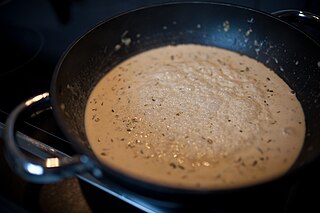
Espagnole sauce is a basic brown sauce, and is one of the mother sauces of classic French cooking. In the early 19th century the chef Antonin Carême included it in his list of the basic sauces of French cooking. In the early 20th century Auguste Escoffier named it as one of the five sauces at the core of France's cuisine.

Suprême sauce is a classic and popular "daughter sauce" of French cuisine. It consists of velouté, a "mother sauce", thickened with cream and strained.

In cooking, a sauce is a liquid, cream, or semi-solid food, served on or used in preparing other foods. Most sauces are not normally consumed by themselves; they add flavor, texture, and visual appeal to a dish. Sauce is a French word probably from the post-classical Latin salsa, derived from the classical salsus 'salted'. Possibly the oldest recorded European sauce is garum, the fish sauce used by the Ancient Romans, while doubanjiang, the Chinese soy bean paste is mentioned in Rites of Zhou 20.

A mirepoix is a mixture of diced vegetables cooked with fat for a long time on low heat without coloring or browning. The ingredients are not sautéed or otherwise hard-cooked, because the intention is to sweeten rather than caramelize them. Mirepoix is a long-standing part of French cuisine and is the flavor base for a wide variety of dishes, including stocks, soups, stews, and sauces.

Roux is a mixture of flour and fat cooked together and used to thicken sauces. Roux is typically made from equal parts of flour and fat by weight. The flour is added to the melted fat or oil on the stove top, blended until smooth, and cooked to the desired level of brownness. A roux can be white, blond (darker), or brown. Butter, bacon drippings, or lard are commonly used fats. Roux is used as a thickening agent for gravy, sauces, soups, and stews. It provides the base for a dish, and other ingredients are added after the roux is complete.
A Mornay sauce is a béchamel sauce with grated cheese added. The usual cheeses in French cuisine are Parmesan and Gruyère, but other cheeses may also be used. In French cuisine, it is often used in fish dishes. In American cuisine, a Mornay sauce made with cheddar is commonly used for macaroni and cheese.

Hollandaise sauce is a mixture of egg yolk, melted butter, and lemon juice. It is usually seasoned with salt, and either white pepper or cayenne pepper.

Blanquette de veau is a French veal stew. In the classic version of the dish the meat is simmered in a white stock and served in a sauce velouté enriched with cream and egg. It is among the most popular meat dishes in France.

Sauce Robert is a brown mustard sauce and one of the small sauces, or compound sauces, derived from the classic French demi-glace, which in turn is derived from espagnole sauce, one of the five mother sauces in French cuisine.

Béarnaise sauce is a sauce made of clarified butter, egg yolk, white wine vinegar, and herbs. It is regarded as a "child" of hollandaise sauce. The difference is in the flavoring: béarnaise uses shallot, black pepper, and tarragon, while hollandaise uses white pepper or a pinch of cayenne.

A velouté sauce is a savory sauce that is made from a roux and a light stock. It is one of the "mother sauces" of French cuisine listed by chef Auguste Escoffier in the early twentieth century. Velouté is French for 'velvety'.

Allemande sauce or sauce parisienne is a sauce in French cuisine based on a light-colored velouté sauce, but thickened with egg yolks and heavy cream, and seasoned with lemon juice. Allemande was one of the four mother sauces of classic French cuisine as defined by Antoine Carême in The Art of French Cooking in the 19th Century.

Albufera sauce is a daughter sauce of French cuisine. It is based on a suprême sauce, which itself derives from the mother sauce velouté.

Soubise sauce is an onion sauce thickened with béchamel sauce, pounded cooked rice, or cream. It is generally served with meats, game, poultry and vegetables. It was formerly often used to coat meat. It is first documented in 1836. It has many variations, the simplest including just onions, butter, and cream.

Sauce poivrade, sometimes called sauce au poivre, is a peppery sauce in French cuisine.

À la Maréchale is a method of food preparation in haute cuisine. Dishes à la Maréchale are made from tender pieces of meat, such as cutlets, escalopes, supremes, sweetbreads, or fish, which are treated à l'anglaise ("English-style"), i.e. coated with eggs and bread crumbs, and sautéed.
Sauce bercy is a classic sauce of French cuisine. The main ingredients are fish stock, velouté sauce, white wine, shallots and butter.

Cardinal sauce is a classic French sauce, with a distinctive red colour coming from lobster butter and cayenne pepper.
Genevoise sauce or Geneva sauce is a type of French brown sauce made from fish fumet, mirepoix, red wine, and butter, usually accompanying fatty fishes such as trout and salmon. Some versions use white wine instead of red wine.





















